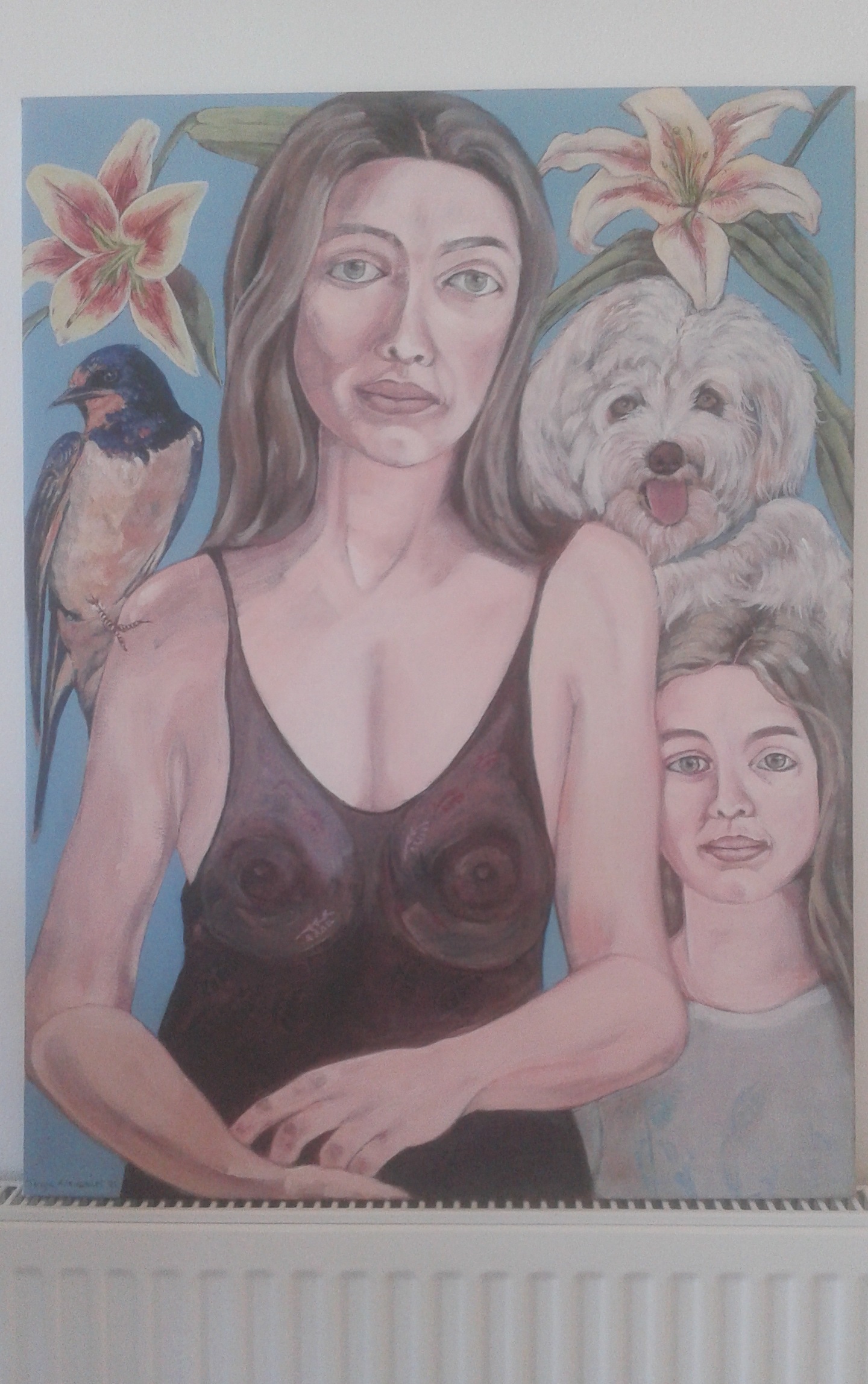Art and animals (Edited)
“The only justifiable stopping place for the expansion of altruism is the point at which all whose welfare can be affected by our actions are included within the circle of altruism. This means that all beings with the capacity to feel pleasure and pain should be included” Peter Singer

Today’s post contains a painting I have been working on over the last three weeks. Even though this canvas is a little bigger than the 50×70 ones I have been using so far, it felt small while I was painting on it. It seems that the figures and objects are somehow bigger than their container, almost pushing their way out of the canvas. I realised this early on in the painting process as I was creating the outline of figures and objects, but after some thought decided to let it evolve this way because while purchasing new canvases and despite my explicit desire to experiment with much bigger ones, I eventually shied away from the idea.
The themes of this painting and perhaps the ones that will follow could be loosely titled my personal ark or imaginary farm. In a TV series I have recently discovered and have been watching on YouTube with the title: Πλάνα με ουρά (https://www.ertflix.gr/category/ellinika-docs/plana-me-oyra/), guests are often asked about the kind of animals they would include in an imaginary ark or farm. I’d definitely include several dogs and birds in my ark or farm. Swallows would be top on my list of flying creatures. Swallows arrive in the Northern hemisphere in April heralding spring. Their journey from Africa up north lasts two months and is one of the longest made by any creature on earth. I read that scientists are not sure why they bother to leave Africa in the first place and some suggest that perhaps in the distant past a genetic mutation created an instinctive wanderlust, an urge to explore new horizons. So, generation after generation they push further up north every year only to set out back home once the weather gets colder.
During the episodes we get to listen to stories of rescue, love and kindness between humans and other animals – pet and inhabitants of rescue and rehabilitation shelters. In most episodes there is mention to animal cruelty and prevention and how sad it is to frequently see that information on the seriousness of animal cruelty goes unnoticed or is minimized when intervention and prosecution occur even though research has demonstrated that cruelty to animals is a signature indicator for other future acts of violence. If someone can be abusive or intentionally cruel to animals, then it makes sense that they could become seriously aggressive towards people. Research has shown repeatedly that there is a connection between animal abuse and interpersonal violence or some form of domestic abuse, for instance. Furthermore, it has been found that children who have been abused or exposed to domestic violence or animal abuse are at risk of developing similar behaviours, and adults who mistreat animals have probably experienced violence or mistreatment in their early life.
More and more we become aware that humans are part of the whole eco system and interdependent with other species, and also, science has shown that we have more in common than we like to think with other mammals and creatures, and ultimately, we all have the same ancestors. In his book Neurodharma Rick Hanson writes “… each of us is a living animal, the result of nearly 4 billion years of biological evolution. Life expressing itself in a particular species; a species expressing itself in a particular body. Our parents had parents who had parents … reaching back eventually to hominid parents a million years ago … who had primate parents 10 million years ago … who had mammalian parents 100 million years ago … all the way back to the first life … from which we have descended in an unbroken line.” Also, all living creatures have some common fundamental needs in order to survive: nourishment, shelter and belonging. In Resilient Forrest and Rick Hanson write: “Every animal species, including human beings, needs its version of safety, satisfaction, and connection. These basic needs are grounded in life itself…” Moreover, like humans all living creatures want to feel pleasure and at ease and they do not want to suffer. In The Little Book of Humanism: Universal lessons on finding purpose, meaning and joy Alice Roberts and Andrew Copson write: “Starting with single-celled organisms, millions of different species evolved here – and are still evolving….. We are one of those species. We are earthlings like every other life form on this planet……. Because we are related to all living things and because we understand what it is to feel pain and pleasure ourselves, this gives us a moral connection to other animals that can feel. The question is not, ‘Can they reason?’ nor ‘Can they talk?’ but ‘Can they suffer?’ ” (Jeremy Bentham, cited in Roberts and Copson, 2020)
Finally, animals have appeared in art since the dawn of time. In Therapy and Clinical Neuroscience (2008) Richard Carr writes that “Archeology suggests that cave painting and rock art from around 18,000 years ago may have captured spiritual or early empathic attempts to become one with animals critical for human survival (Potts 2007). These artistic expressions arose from the artists altering their state of mind so that attunement with the habits of prey or with illnesses shared with prey became easier to understand. Flowers strewn over a gravesite, decorations on bone and shell necklaces, cave paintings, Egyptian murals, and eventually modern art and architecture command that we acknowledge repeated and spirited attempts to understand, represent, change, share and define a world altered by psychosocial sensory and emotional creations.”
